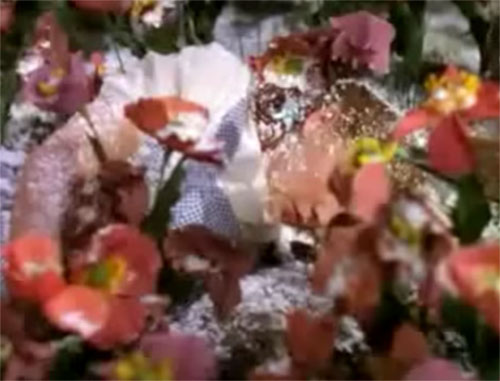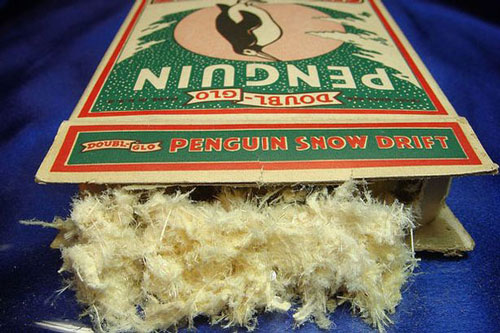Asbestos: It Isn't Snow
Asbestos is the rare example of a widely used mainstream product that was litigated out of existence. BTW, it was used for fake snow in The Wizard of Oz.
27.5M
The number of workers who were exposed to asbestos between 1940 and 1979, according to a 1986 report by the American Thoracic Society. It took decades for asbestos to be considered dangerous enough so as to be removed from general use. The for-profit Asbestos.com notes that health issues related to asbestos were detected as far back as 1897 and the material was linked to mesothelioma as far back as the 1930s, but no rules limiting exposure were passed until the 1970s.

Asbestos was once used as fake snow in classic movies
For decades, The Wizard of Oz was one of the most iconic movies on broadcast television, showing up on at least one network over a four-decade stretch.
Somewhat lost on the public all those years is the fact that, every time you watch it, you're watching a film that's literally dousing its main characters in carcinogens.
That's not hyperbole, either. See, during the early days of Hollywood, fake snow was commonly used in place of the real thing, and there weren't any computerized effects that could make snow. At first, cotton was used. But then a firefighter on a film set pointed out how bad an idea it was to cover the stage with a material that tends to help fire spread.
Despite the fact that asbestos' health risks were already known at the time, film sets started using one of the purest forms of asbestos on film stages—in part because it was fireproof and looked close enough to snow that it could fool the audience.
The effect was widely used by films of the era, but perhaps best known for Wizard of Oz's "poppy field" scene, where Dorothy is awoken from a deep slumber after Glinda, the Good Witch of the South, introduces snow to the scene.
That white stuff covering Judy Garland? Pure asbestos, of course—in chrysotile form, making the material a bit more dangerous than, say, in building material. (By the way, not exactly a nice gesture on the part of the Good Witch there, but odds are good she didn't know about mesothelioma, because not a lot of people did.)
In defense of Metro-Goldwyn-Mayer and other users of asbestos snow in the 1930s, this stuff was common, and not only on film sets. It was not unheard of during this period to purchase Christmas supplies that included a form of fake snow made of asbestos.
But the heavy use of the substance in The Wizard of Oz stands out, not only because the movie is so famous, but because it highlights the utility that the material played in filmmaking. The snow wasn't the only asbestos-laden element of production: The Wicked Witch's broom was made of asbestos, as was the Scarecrow's entire outfit.
In both of these cases, the material was used in a somewhat safer way that it was during the snow scene, but in the clothing case in particular, the risk of wearing it is high. If the costume were to tear, the fibers of the asbestos could have gone into Ray Bolger's lungs, creating significant health problems down the line.
(This was not a hypothetical concern: Buddy "Jed Clampett" Ebsen, who was originally to play the Tin Man, was made severely ill by the powdered aluminum he wore on his face, with the material leaving him so ill he nearly died. Ebsen was eventually replaced; he would have to wait another quarter-century for his shot at immortality.)
These days, fake snow is a little more elaborate than the stuff used back in the '30s. We've created more elaborate techniques to mimic the effect—such as the "chemical snow" used in It's a Wonderful Life, and the marble dust used in Dr. Zhivago. Sometimes, movies will use actual snow.
But for a while, we were covering some of our greatest movie stars in one of the most dangerous natural substances known to man. (Does this ruin the movie for you, in a way? Sorry. Not my intention.)
"The industry's survival has been due largely to its success in keeping alive the fiction that asbestos can be used safely. Arguably its most potent weapons have been the suppression of evidence about the hazards of asbestos and even the corruption of science to promote doubt about the mineral's toxicity."
— Historian Jock McCulloch, discussing in a 2006 academic article for Public Health Reports the role the asbestos industry has played in keeping the material on the market in various forms. This is a common theme that critics of asbestos emphasize online—the for-profit clearinghouse Asbestos.com, for example, features a lengthy timeline naming industry executives and corporations it believed had manipulated information to keep asbestos on the market. One exec quoted by the website had this particularly crass line to internally drop about the matter in 1966: "If you have enjoyed a good life while working with asbestos products, why not die from it."

Asbestos has not been an easy material to quit, but its problems have changed the legal system forever.
The problem with the quitting asbestos in one fell swoop, as anyone who has researched this issue at any depth can tell you, is that it's everywhere—embedded in nearly every major building created between the 1950s and the 1970s.
If you walk into a building of a certain age, odds are very high that the floor you're standing on has asbestos embedded inside, though not in its most dangerous friable form, when it isn't mixed with secondary materials. But it's played an important role in building construction over the years, thanks to its value for specific uses like fireproofing.
And the building industry spent a very long time attempting to hold onto the material despite its clear health risks. Part of the reason for this is that the material used to be seen as one of the most innovative tools in the manufacturing toolkit. It'd be like finally figuring out a good use for graphene and finding out it was radioactive.
This 1952 clip from the Asbestos-Cement Products Association, produced years after the health issues were clearly laid out, still holds onto that "wonder-material" line:
"It was natural that the scientists would turn to asbestos, for this is a remarkable mineral," the video states.
To put it simply, it was an engineering and social problem as much it is a health problem.
Unless you're knee-deep in the asbestos industry, you probably don't really need to know the engineering problems, but you've most assuredly seen the social nature of this problem in action, because it's widely considered one of the most common topics for class action lawsuits, because so many people have been affected by the disease.
The widespread nature of the problem means that there are lots of organizations looking to help. To this day, it's common to see ads like these on broadcast digital substations:
The scope of the cases kind of gives them a bit of a pump-and-dump feel. In a book on the topic titled Compensating Asbestos Victims: Law and the Dark Side of Industrialization, author and Bryant University professor Andrea Boggio notes the impact asbestos cases have had on the court system:
Four decades after Borel was decided, it is safe to say that asbestos litigation changed the landscape of tort and product liability litigation in the United States. It solidified the plaintiff bar and transferred to it enormous amounts of money. The accumulated wealth was used by the plaintiff bar to pursue other mass torts and to influence policy at national and local level. Furthermore, this wave of cases showed US courts' failure to deliver efficient and individualized justice for mass torts. The bulk treatment of victims on part of law firms and the standardized life of cases after entering the court system "sacrificed attention to individualized injuries and needs."
One sign of the unprecedented landscape around asbestos and mesothelioma in the legal system is the fact that, as I mentioned earlier, Asbestos.com is a for-profit firm, even though it looks like a nonprofit educational resource.
But the reason that it's for-profit can be seen through the ownership of its website: The Peterson Firm, the company listed as the website's owner, is a law firm that specializes in class-action lawsuits, and it partly owns the first site that people will search for when they want to learn about asbestos.
Perhaps the great legacy of asbestos won't be fire-retardant suits, but innovative approaches to lawyering.
The whole saga with The Wizard of Oz I highlighted above, in its own way, has something of a modern parallel, if an inexact one.
Currently, the Motion Picture Association of America is grappling with a lawsuit regarding the portrayal of smoking in films. The class-action suit involves a product that, like asbestos, many are trying to limit due to its carcinogenic nature.
Smoking, in ways significantly more widespread than even asbestos, has become the modern product that we're trying to stop. Many of us want to blunt its cultural influence, to smother the problem, to stop the thing that's causing people to get sick.
And that's an understandable concern. But as asbestos exemplifies, even when we know something is dangerous, we as a society still struggle to change course.
Do the additional lawyers help?
:format(jpeg)/2017/06/tedium072816--1-.gif)
/2017/06/tedium072816--1-.gif)

/uploads/ernie_crop.jpg)